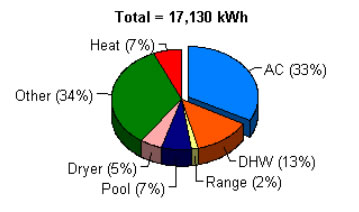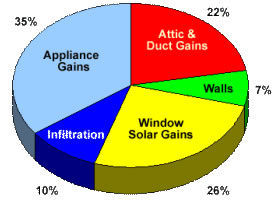| |
|
| |
| Reference
Publication:
Chandra, Subrato, Neil Moyer, Danny Parker, David Beal,
David Chasar, Eric Martin, Janet McIlvaine, Ross McCluney,
Andrew Gordon, Mike Lubliner, Mike McSorley, Ken Fonorow,
Mike Mullens, Mark McGinley, Stephanie Hutchinson, David
Hoak, Stephen Barkaszi, Carlos Colon, John Sherwin,
Rob Vieira, and Susan Wichers. Building America Industrialized
Housing Partnership, Annual Report - Sixth Budget Period.
4/1/04 - 3/31/05. |
|
|
| Building
America Industrialized Housing Partnership, Annual
Report - Sixth Budget Period |
|
|
Subrato
Chandra, Neil
Moyer, Danny
Parker, David
Beal, David
Chasar, Eric
Martin,
Janet
McIlvaine, Ross
McCluney, Andrew
Gordon, Mike
Lubliner, Mike
McSorley,
Ken
Fonorow, Mike
Mullens, Mark
McGinley, Stephanie
Hutchinson, David
Hoak,
Stephen
Barkaszi, Carlos
Colon, John
Sherwin, Rob
Vieira, and Susan
Wichers. |
|
| Florida
Solar Energy Center |
|
| |
|
|
III.
BAIHP Research
|
Figure 43 Distribution
of Residential Energy Consumption measured in
171 Florida homes shows typical energy profile
for homes in hot-humid climates. Source: Parker,
D. S., 2002. "Research
Highlights from a Large Scale Residential Monitoring
Study in a Hot Climate." Proceedings of International
Symposium on Highly Efficient Use of Energy and Reduction
of its Environmental Impact, pp. 108-116, Japan Society
for the Promotion of Science Research for the Future
Program, JPS-RFTF97P01002, Osaka, Japan, January 2002.
(Also published as FSEC-PF369-02, Florida Solar Energy
Center, Cocoa, FL.) |
|
Figure 44 Typical
components of annual residential cooling load in
hot-humid climates. Source: Florida Solar Energy
Center web site: http://www.fsec.ucf.edu/bldg/fyh/priority/Index.htm
|
BAIHP conducts research with Industry Partners in manufactured
and site built housing and using the laboratory facilities
at the Florida Solar Energy Center.
Research Context for Hot-Humid Climate
The primary opportunities for improving energy efficiency
can be generalized into two categories: increasing equipment
efficiency and reducing equipment loads. The latter of these
contributes to improving comfort, durability, and indoor
air quality also.
In
hot humid regions, the primary building energy use (Figure
43) is air conditioning (AC) with heating making up
only a small portion of total. As in other climates, water
heating constitutes the second largest residential energy
draw. Refrigerators follow just ahead of other household
appliances such as stoves and dryers.
The primary loads on residential AC systems (Figure
44) are appliance generated heat, window radiant heat
gain, attic and duct related heat gain, infiltration (primarily
latent heat gain), and wall heat gain coming in last.
By
systematically evaluating the savings potential technologies
and construction techniques, research provides the home
building industry with vital information needed to meet
the Department of Energy’s industry
challenges of building high performance homes. BAIHP Research
presented here is grouped into three categories:
- Manufactured Housing Research
- Site Built Housing Research
- Field
and Laboratory Building Science Research.
|
Disclaimer:
This report was prepared as an account of work sponsored by an agency
of the United States government. Neither the United States government
nor any agency thereof, nor any of their employees, makes any warranty,
express or implied, or assumes any legal liability or responsibility
for the accuracy, completeness, or usefulness of any information,
apparatus, product, or process disclosed, or represents that its use
would not infringe privately owned rights. Reference herein to any
specific commercial product, process, or service by trade name, trademark,
manufacturer, or otherwise does not necessarily constitute or imply
its endorsement, recommendation, or favoring by the United States
government or any agency thereof. The views and opinions of authors
expressed herein do not necessarily state or reflect those of the
United States government or any agency thereof.
|


 You
are here: >
You
are here: > 
